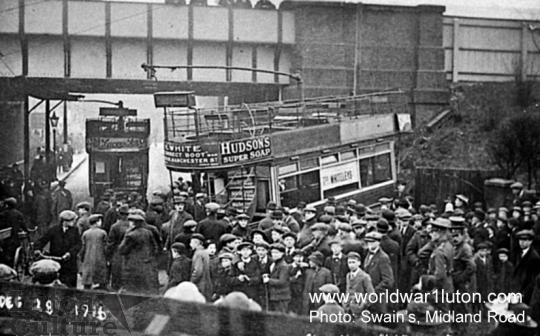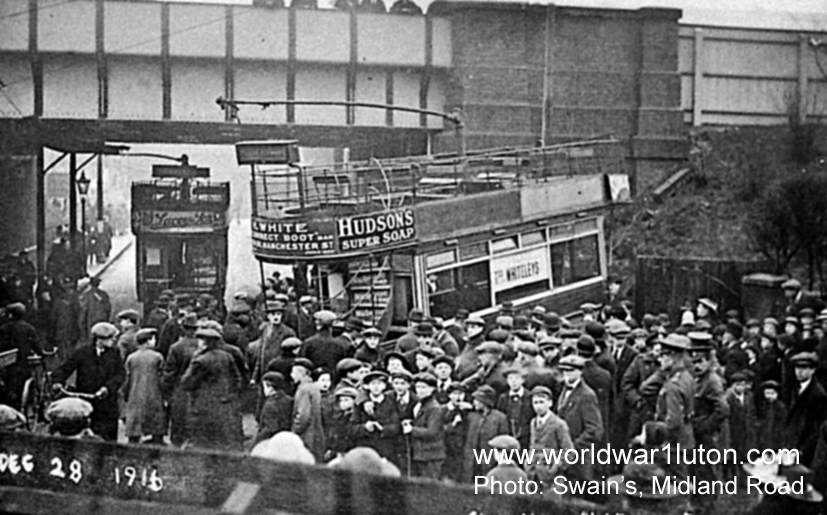Seven hurt in 1916 tram smash

Seven people were injured, including the driver and two children, when this Luton tram jumped the tracks and crashed into an earth bank abutting the Midland Railway bridge at the junction of Midland Road and Old Bedford Road at 11.30 am on Thursday, December 28th, 1916.
Motorman (driver) Alfred Lloyd, aged 46, a married man with six children living at 7 Victoria Street, Luton, was unconscious and in a critical condition, suffering from internal injuries, when taken to the Bute Hospital in Dunstable Road, where he was detained. He recovered consciousness as his wife arrived to see him, having initially been told he had been killed.
Mr David Peck, foreman of the Corporation's sanitary department had to use a crowbar as a lever to removed some of the wreckage that enabled Mr Lloyd to be freed. The driver, who had worked on the trams for 12 months previously without incident, was still clutching the brake when he was removed unconscious.
Tram conductor Arthur Eaton, of 21 South Road, Luton, was treated at the Bute Hospital for shock and cuts to his face. He was then allowed home.
The most seriously injured passenger was Mrs Wooding, wife of High Town Road grocer Mr James J. Wooding, who lived at 40 Havelock Road. She was detained in the Bute Hospital with severe wounds to the scalp and face.
Acting Borough Chief Constable Mr Walter James Hagley, of 14 Salisbury Road, Luton, was allowed home after treatment for a dislocated shoulder at the Medical Institute, Waller Street. He also had slight cuts to his face.
Miss Kate Brandham, of 390 Hitchin Road, Luton, was allowed home after treatment at the Bute Hospital for cuts, bruises and shock.
Four-year-old Charles Gregory, of 19 Brache Street, Luton, was detained in the Bute Hospital with leg and arm injuries.
And Constance Gregory, aged 10 and also of 19 Brache Street, was allowed home after treatment by Dr Harmar for a scalp wound and shock.
A Luton News report the following day said the junction was approached from Midland Road down a steep incline that ended in a curve of little more than a right angle and demanded the greatest care to negotiate. There had been other lesser incidents of trams leaving the track at that point.
The tram involved in the smash had come down High Town Road with seven or eight passenger on board. Nothing appeared to be wrong until the tram was half way down Midland Road when, according to eyewitnesses, it was exceeding the regulation pace of 4 mph. But the reason why it was travelling at about 12 mph remained a mystery.
As the tram neared the bottom of the hill it was evident that an accident was unavoidable. The tram failed to negotiate the curve, struck an electric standard and finally crashed through the wooden fence into the earth bank abutting on the Midland Railway bridge.
The body of the tram was quite wrecked. The front was smashed in, with the driver among the debris. An idea of the impact could be gathered from the fact that the seats were literally torn out of their bracings, the staircase at the driver's end was a twisted and broken frame and woodwork splintered and windows broken. The splinters of wood and glass caused most of the wounds.
Acting Chief Constable Hagley told a reporter that had got on the tram at Havelock Road along with Mrs Wooding. "It came along all right the first part, but when we got to Dudley Street I thought it was going rather fast. When the car gathered impetus and began to sway just below that road, I began to feel that we were in for trouble.
"I have seen cars (trams) come down there rather fast, however, and I thought the driver might negotiate the corner all right. I braced myself, however, for the shock which might come, hanging my limbs quite loosely, and it was a good thing I did for in a trice the car jumped the rails at the bottom, dashed over the kerb and crashed into the fence and bank.
"The impact was terrific, and simultaneously with the crash something flew through the car and struck me hard on the shoulder and face."
One eyewitness to the crash said he had been expecting a smash-up at the corner for a long time. But he said: "To me it is a great mystery how it happened, and I know something about tramcars. I also know know that there are four brakes to every car, and all of them could not have failed to act. Also, sand had been thrown down, so the rails were not unduly slippery, and I understand the driver was a most reliable servant of the company...fully acquainted with the responsibility of the task."
Half an hour after the crash, a steam tractor returned the stricken tram to the rails to tow back to the Park Street depot.
At a Town Council meeting in January, it was stated that that accident had been thoroughly gone into with Tramways Manager Mr A. E. Wray and no fault could be found with the overhead equipment or the tram involved. A demonstration, including the application of the brakes, showed everything was in order.
Deputy Mayor Councillor Walter Primett said he believed the regulations stated that on certain gradients the speed should not be more than four miles an hour. He was there to say that trams did not come down only at four or eight miles and hour, but at 10 and 12 mph. He believed one or two men had been sacked because of this very thing.
Councillor Henry Impey said that if the drivers would pay attention to the Board of Trade stops, whether there were passengers waiting or not, they could not gather a speed which would lead to trouble. And Councillor Escott said there was one of those stops within 12 yards of the curve where the accident occurred, so if the tram had stopped there the accident would not have happened.
On February 19th, 1917, there was another serious accident when two trams collided head on in thick fog in Dunstable Road, near Moor Street. Fortunately, no-one was injured on that occasion and neither tram was derailed. A tram heading from town to the laundry in Dunstable Road passed over a loop outside the Gas Works and collided on a single line section of track with a tram approaching the loop from the opposite direction.
And on May 23rd, 1917, a young woman named Olive Byfield, aged 19, was on a Dunstable Road tram and intending to alight at Park Street. But the tram turned into Chapel Street and she was flung from the vehicle on a loop at the bottom of Stuart Street after asking to get off at Pike's Close. Her injuries included a broken collar bone.
When buses replaced trams in Luton in 1932 passenger numbers soared.
[Luton News, December 29th, 1916; January 11th, 1917]
Event Place
Author: Deejaya
Book navigation pager
- Printer-friendly version
- Log in or register to post comments




Add comment